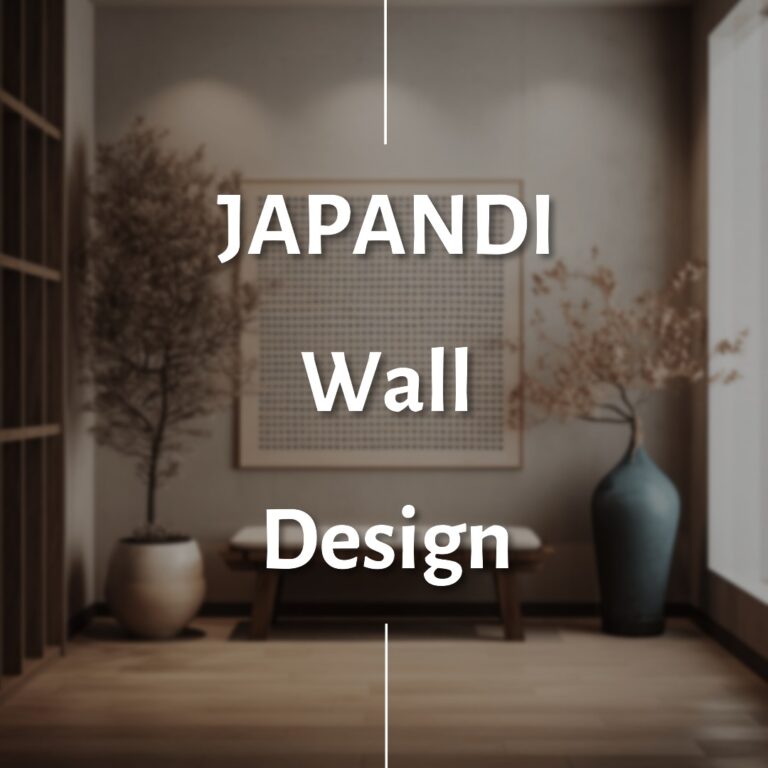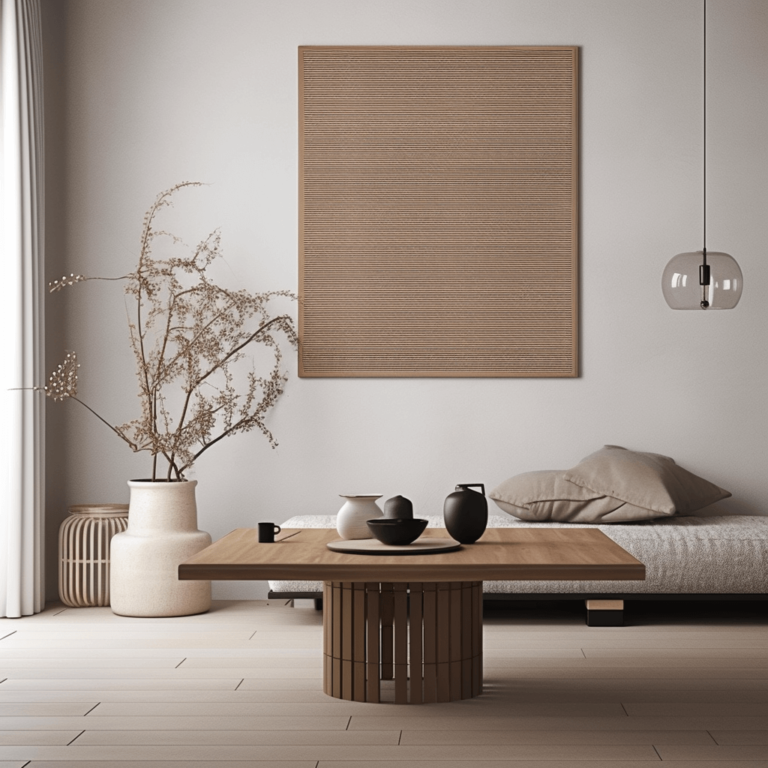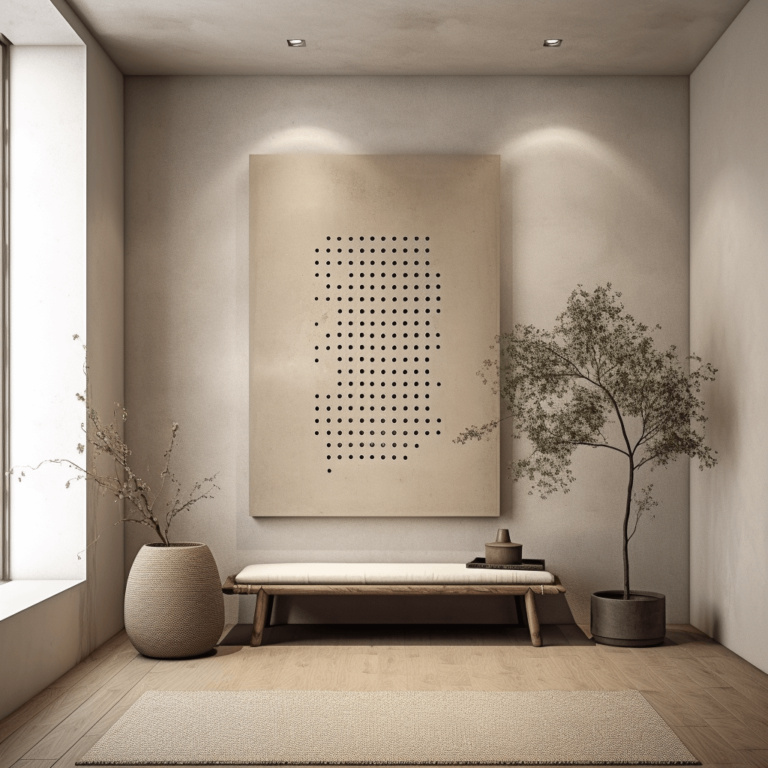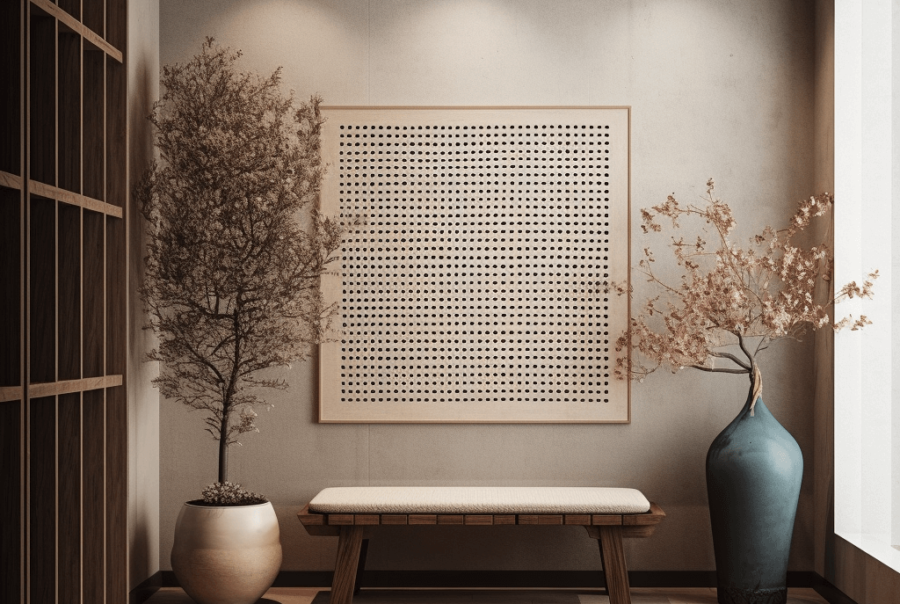TABLE OF CONTENTS:
Introduction

Japandi Definition and Origin
Japandi is a design concept that combines the best of Japanese and Scandinavian design principles. This fusion of two seemingly distinct aesthetics results in a style that is both functional and visually stunning. The term “Japandi” is derived from the words “Japanese” and “Scandinavian,” and it has gained significant traction in the interior design world in recent years.
Key Principles: Minimalism, Functionality, and Natural Elements
The core principles of Japandi design revolve around three key concepts:
- Minimalism: Emphasizing clean lines, simple forms, and a limited colour palette.
- Functionality: Ensuring that every element in a space has a purpose and contributes to a harmonious atmosphere.
- Natural Elements: Incorporating materials and textures inspired by nature to create a calming and grounding environment.
Understanding Japandi Aesthetics

Japanese Design Elements
-
Wabi-Sabi: Embracing Imperfection
Wabi-sabi is a Japanese aesthetic principle that embraces the beauty of imperfection and impermanence. In Japandi wall design, this translates to incorporating materials with natural irregularities and textures, such as raw wood, handmade ceramics, or aged metal accents. This can also be achieved by showcasing Japandi wall art or decorative items that exhibit the passage of time and have a story to tell.
-
Kanso: Simplicity and Eliminating Clutter
Kanso is the Japanese concept of simplicity, which emphasizes eliminating clutter and using only essential elements in a space. To achieve this in Japandi wall design, consider removing unnecessary decorations or artwork, and opt for a single statement piece or a carefully curated collection of items that reflect the desired aesthetic.
Scandinavian Design Elements
-
Hygge: Creating a Cozy Atmosphere
Hygge is a Danish concept that embodies the idea of creating a cosy, warm, and inviting atmosphere. In Japandi wall design, this can be achieved by incorporating soft textures such as linen, wool, or faux fur. Consider adding plush cushions, cosy throws, or textured wall hangings to create a sense of comfort and warmth.
-
Lagom: Balance and Moderation
Lagom is a Swedish principle that emphasizes balance and moderation in all aspects of life, including interior design. In the context of Japandi wall design, this means striving for a harmonious blend of both Japanese and Scandinavian elements. Achieving the perfect balance may involve combining clean lines and minimalism with organic materials, or finding the right mix of warm and cool tones in your colour palette.
Merging Japanese and Scandinavian Design Principles
To successfully merge Japanese and Scandinavian design principles in Japandi wall design, focus on creating a space that feels both calming and inviting. This can be achieved by incorporating a mix of natural materials, such as wood, stone, and textiles, along with a restrained colour palette that features soothing tones like off-white, beige, gray, and muted greens or blues. Additionally, consider incorporating elements of both Wabi-sabi and Kanso by selecting artwork or decorative items that reflect these concepts, and strive for a balanced and harmonious arrangement that embodies the spirit of Lagom.
Japandi Wall Design Guide
Japandi wall design combines the elegance of Japanese aesthetics with the warmth and simplicity of Scandinavian design. In this section, we will explore various colour schemes, textures and materials, and wall treatments that can help you achieve a harmonious Japandi-style interior.

Color schemes
Neutral and earthy tones: Japandi colour schemes are all about creating a serene and calming atmosphere. Incorporate neutral shades such as beige, off-white, and gray, combined with earthy tones like olive green, terracotta, and muted blues to establish a well-balanced, soothing ambience.
Bold, yet restrained accents: While the overall colour palette should remain understated, you can add pops of color with carefully chosen accents. Consider using deep indigo, burnt orange, or forest green in moderation to create visual interest without overwhelming the senses.
Textures and materials
Natural wood finishes: Wood is a key component in Japandi design. Opt for light-toned woods like ash, oak, and birch to create a warm and inviting atmosphere. Consider using wooden wall panels or exposed beams to introduce natural textures and a sense of depth.
Organic japandi textures: linen, rattan, and bamboo: Incorporate organic materials such as linen, rattan, and bamboo to achieve a tactile, nature-inspired environment. These elements can be introduced through window treatments, wall hangings, or even as part of a feature wall.
Plaster and concrete: To balance the warmth of wood and organic materials, consider integrating plaster or concrete finishes. These can provide a subtle, industrial edge and contribute to the overall minimalistic aesthetic.
Wall treatments
Shoji screens and sliding doors: Traditional Japanese shoji screens or sliding doors can be used as room dividers or as a unique wall feature. These elements not only add a sense of Zen but also help maximize space and light.
Japandi Accent walls: japandi style wallpaper and painting techniques: Create a focal point in your Japandi interior with an accent wall. Experiment with textured wallpaper, such as grasscloth or Japanese washi paper, or try paint techniques like color blocking or sponging to introduce depth and dimension.
Japandi Wall art and decor: minimalist and nature-inspired: Complete your Japandi wall design with carefully curated wall art and decor. Opt for minimalist, nature-inspired pieces such as ink paintings, framed botanical prints, or simple ceramics to reinforce the theme.
Tips for Choosing the Right Japandi Wall Decor
The Japandi style is an innovative fusion of Japanese and Scandinavian design principles, highlighting minimalism, functionality, and natural elements. In this section, we’ll delve into selecting the right Japandi wall decor to enhance your space, focusing on scale and proportion, quality and craftsmanship, and balancing form and function.

Selecting the right scale and proportion
Size matters: When choosing wall decor, consider the dimensions of your room and the existing furniture. Opt for larger pieces to create a focal point in spacious areas, while smaller artwork or accessories can add subtle accents in more compact rooms.
Balance and harmony: Japandi design values balance and harmony. When selecting wall decor, ensure it complements the surrounding elements without overwhelming the space. This may involve pairing a large, statement piece with smaller, more delicate items to create visual interest and equilibrium.
Focusing on quality and craftsmanship
Sustainable materials: Japandi design is rooted in sustainability and environmental consciousness. Choose wall decor made from natural, eco-friendly materials such as wood, bamboo, or recycled textiles.
Artisanal quality: The craftsmanship of wall decor should showcase the intricate skill of the artist or artisan. Handmade, one-of-a-kind pieces not only elevate the aesthetic but also tell a unique story.
Balancing form and function
Functional wall decor: Japandi design encourages the use of functional japandi wall decor items, like shelves or hooks, which serve a purpose beyond mere aesthetics. Incorporate wall-mounted storage solutions or floating shelves to blend style and practicality.
Minimalism and simplicity: Choose wall decor that embodies the minimalist essence of Japandi design. Avoid excessive ornamentation, and opt for clean lines, muted colors, and natural textures.

10 Japandi Wall Design Ideas
Let’s dive into ten inspiring Japandi wall design ideas to help you transform your space into a harmonious haven.

Idea #1: Shoji screens and room dividers
As mentioned earlier, shoji screens or sliding doors can add a touch of Japanese authenticity to your Japandi interior, while also providing functional benefits such as dividing rooms or creating privacy.
Idea #2: Exposed wooden beams
Showcase the beauty of natural wood by incorporating exposed beams into your space. This architectural feature can add character and depth to any room, while also reinforcing the Japandi aesthetic.
Idea #3: Vertical gardens and green walls
Bring the outdoors in with a living wall or vertical garden. This eco-friendly design element not only adds a lush, calming atmosphere but also improves air quality and promotes well-being.
Idea #4: Japandi accent walls with contrasting textures
Experiment with contrasting textures, such as a concrete or plaster accent wall juxtaposed against warm wooden elements. This will create visual interest and balance the Japandi aesthetic.
Idea #5: Wall-mounted storage solutions
Embrace the minimalist ethos of Japandi design by incorporating sleek, wall-mounted storage solutions. Floating shelves, pegboards, or modular systems can help keep your space organized while maintaining a clean and clutter-free look.
Idea #6: Natural fibre wall hangings
Enhance your Japandi interior with natural fibre wall hangings such as macramé, woven tapestries, or sisal artworks. These pieces can add warmth, texture, and a handmade touch to your space.
Idea #7: Floating shelves with curated displays
Use floating shelves to showcase a carefully curated collection of objects that reflect your personal style and interests. Keep it minimal by selecting a few statement pieces, such as ceramics, plants, or framed prints, and avoid overcrowding the display.
Idea #8: Minimalist japandi gallery walls
Create a Japandi-inspired gallery wall using a mix of minimalist art, nature-inspired prints, and simple frames. Stick to a cohesive colour palette and avoid cluttering the space with too many pieces.
Idea #9: Earth-toned wall murals
Introduce a sense of tranquillity and connection to nature with a large-scale, earth-toned wall mural. Choose a design that reflects the Japandi aesthetic, such as a forest landscape, abstract patterns, or simple geometric shapes.
Idea #10: Traditional Japanese Calligraphy
Incorporate traditional Japanese calligraphy, also known as shodo, into your wall design. Hang a framed calligraphy scroll or artwork to create a focal point and add a touch of cultural authenticity to your Japandi interior.
By incorporating these Japandi wall design ideas and principles, you can create a harmonious, inviting space that blends the best of Japanese and Scandinavian design. Remember to focus on natural materials, earthy colour palettes, and minimalistic aesthetics to achieve the perfect Japandi balance.

Conclusion
Embracing the Japandi wall design in your space can create a serene, clutter-free environment that balances form and function. By considering scale and proportion, focusing on quality and craftsmanship, and implementing smart design solutions for small spaces, you can achieve an elegant, cohesive look that resonates with the Japandi aesthetic.




